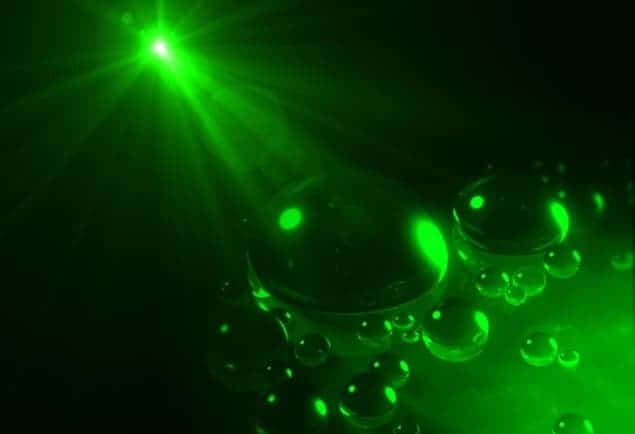
Researchers in Florida and Singapore have produced a method of dragging objects on the surfaces of fluids that they believe could lead to new techniques for micromanipulation. The team has shown that its “tractor beam” can manipulate objects over macroscopic distances along a chosen interface of two materials with different refractive indices.
Push and pull
While science fiction has long relished tales of unfortunate vessels being dragged to their doom by tractor beams, the more benign ambitions of physicists include optical micromanipulation of particles in biomedical experiments and chemical engineering. Any scientist trying to produce an attractive force from radiation has to contend with the fact that photons carry momentum and when a particle absorbs a photon it must absorb that momentum, pushing the particle away from the light source. But what if the object does not absorb the radiation?
Groups such as Pavel Zemánek‘s at the Institute of Scientific Instruments of the Academy of Sciences in the Czech Republic have irradiated objects symmetrically off-axis so that they scatter light forward, giving them recoil momentum directed back toward the light sources. Other researchers such as David Grier’s team at New York University have created “optical conveyor belts” – streams of backward-moving optical traps that reel objects in. These are all approximations, however, to true tractor beams, which would use a single, unstructured beam of light to pull the object.
In the new research, members of Aristide Dogariu‘s group at the University of Central Florida, together with colleagues at the National University of Singapore, show that simple, unstructured light passing from a fluid of low refractive index to one of higher refractive index pulls transparent objects suspended at the interface back towards the light source. In the late 1800s, the mathematician Hermann Minkowski showed that a photon’s momentum increases proportionally as the refractive index of the medium through which it is propagating increases. If a transparent object is suspended at the interface between these two media, photons exit the object with greater momentum than they had on entry. To conserve momentum, therefore, the object at the interface must be pulled in the opposite direction to the photon flow, whatever the refractive index of the object itself. This photonic force will be far too weak to overcome the surface tension and actually free the object from the interface.
Photonic forces
“It’s very hard to take a floating object on the surface of a fluid and either pull it out of the fluid or push it down into the fluid,” Dogariu explains. Practical effects can be produced, however, if the object is illuminated at an oblique angle to the interface, in which case photons still pass through the object from a lower to a higher refractive index medium, but there is a transverse component to the resulting force. This transverse component can be used to pull objects along the interface. The researchers tested this by obliquely illuminating oil droplets on the surface of water. They found that the droplets within the illumination spot of the beam showed an obvious movement towards the light source, whereas droplets not illuminated showed, on average, no such movement.
Despite the fact that it can only pull objects around at the interface between two fluids, Dogariu believes that the research could have important applications. “The properties of many systems are practically determined by their interfaces, from colloidal systems to cell biology,” he says. “What we are after is practically being able to manipulate the properties of these interfaces with optical forces.” He lists optical sorting as one principal application. All particles will absorb some photons passing through them, and when a particle absorbs a photon instead of transmitting it, it will be pushed rather than pulled. “If you have two species that have different levels of absorption, they will have different absolute velocities on the surface,” he explains.
Grier, who was not involved with this work, is more sceptical about the potential for direct application of the work. He points out that a similar technique called photophoresis already exists that sorts particles in suspension according to how much they are pushed by radiation. He is also concerned that, if particles absorb radiation, they will dissipate heat, which could lead to hydrodynamic effects disrupting the movement. Nevertheless, he is intrigued by the fundamental physics of the research and thinks that it could lead to interesting further work. “The medium has largely been ignored in the process of scaling up tractor beams,” he says. “This paper really introduces the idea that you can use the medium as part of the process.”
The research is published in Nature Photonics.



